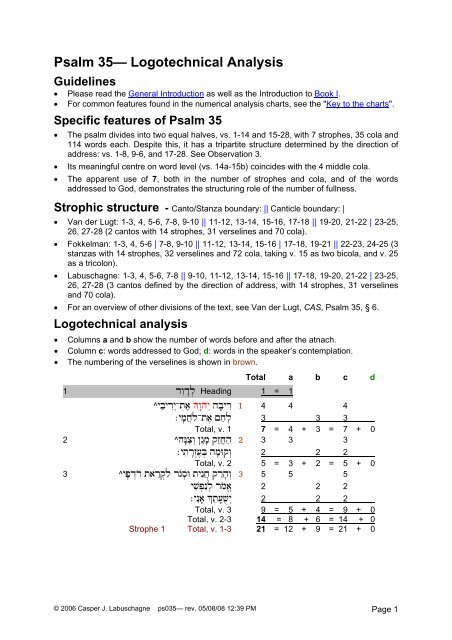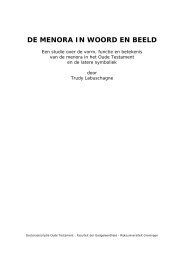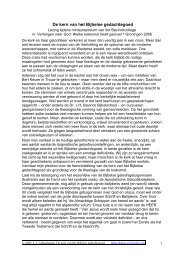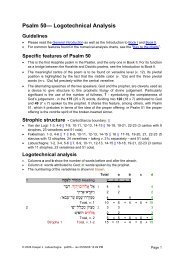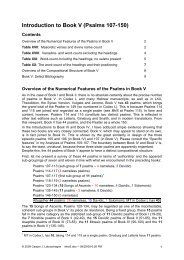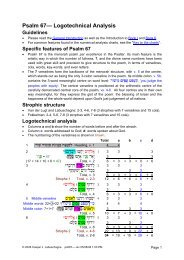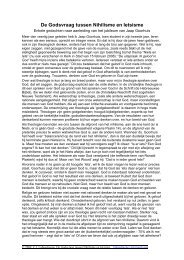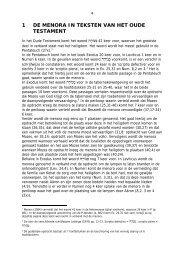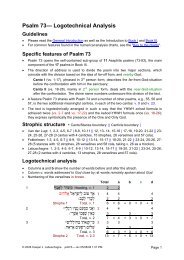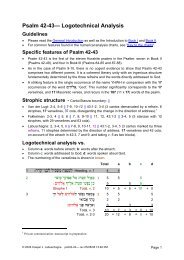Logotechnical Analysis of Psalm 35 - labuschagne
Logotechnical Analysis of Psalm 35 - labuschagne
Logotechnical Analysis of Psalm 35 - labuschagne
You also want an ePaper? Increase the reach of your titles
YUMPU automatically turns print PDFs into web optimized ePapers that Google loves.
<strong>Psalm</strong> <strong>35</strong>— <strong>Logotechnical</strong> <strong>Analysis</strong><br />
Guidelines<br />
• Please read the General Introduction as well as the Introduction to Book I.<br />
• For common features found in the numerical analysis charts, see the "Key to the charts".<br />
Specific features <strong>of</strong> <strong>Psalm</strong> <strong>35</strong><br />
• The psalm divides into two equal halves, vs. 1-14 and 15-28, with 7 strophes, <strong>35</strong> cola and<br />
114 words each. Despite this, it has a tripartite structure determined by the direction <strong>of</strong><br />
address: vs. 1-8, 9-6, and 17-28. See Observation 3.<br />
• Its meaningful centre on word level (vs. 14a-15b) coincides with the 4 middle cola.<br />
• The apparent use <strong>of</strong> 7, both in the number <strong>of</strong> strophes and cola, and <strong>of</strong> the words<br />
addressed to God, demonstrates the structuring role <strong>of</strong> the number <strong>of</strong> fullness.<br />
Strophic structure - Canto/Stanza boundary: || Canticle boundary: |<br />
• Van der Lugt: 1-3, 4, 5-6, 7-8, 9-10 || 11-12, 13-14, 15-16, 17-18 || 19-20, 21-22 | 23-25,<br />
26, 27-28 (2 cantos with 14 strophes, 31 verselines and 70 cola).<br />
• Fokkelman: 1-3, 4, 5-6 | 7-8, 9-10 || 11-12, 13-14, 15-16 | 17-18, 19-21 || 22-23, 24-25 (3<br />
stanzas with 14 strophes, 32 verselines and 72 cola, taking v. 15 as two bicola, and v. 25<br />
as a tricolon).<br />
• Labuschagne: 1-3, 4, 5-6, 7-8 || 9-10, 11-12, 13-14, 15-16 || 17-18, 19-20, 21-22 | 23-25,<br />
26, 27-28 (3 cantos defined by the direction <strong>of</strong> address, with 14 strophes, 31 verselines<br />
and 70 cola).<br />
• For an overview <strong>of</strong> other divisions <strong>of</strong> the text, see Van der Lugt, CAS, <strong>Psalm</strong> <strong>35</strong>, § 6.<br />
<strong>Logotechnical</strong> analysis<br />
• Columns a and b show the number <strong>of</strong> words before and after the atnach.<br />
• Column c: words addressed to God; d: words in the speaker’s contemplation.<br />
• The numbering <strong>of</strong> the verselines is shown in brown.<br />
1 d«wfld¸l Heading 1 = 1<br />
Total a b c d<br />
^yabyÊrÃy-te' h√whÃy hAbyÊr 1 4 4 4<br />
:yAm·x»l-te' £ax¸l 3 3 3<br />
Total, v. 1 7 = 4 + 3 = 7 + 0<br />
2 ^h√FnicÃw §≈gAm q≈z·xah 2 3 3 3<br />
:yitflrÃzev¸–b hAm˚qÃw 2 2 2<br />
Total, v. 2 5 = 3 + 2 = 5 + 0<br />
3 ^yApËdOr t'firŸqil rOg¸s˚ ty«n·x q„rAhÃw 3 5 5 5<br />
yiH¸p¬n¸l rOmÈ' 2 2 2<br />
:y«nA' EtAvuHÃy 2 2 2<br />
Total, v. 3 9 = 5 + 4 = 9 + 0<br />
Total, v. 2-3 14 = 8 + 6 = 14 + 0<br />
Strophe 1 Total, v. 1-3 21 = 12 + 9 = 21 + 0<br />
© 2006 Casper J. Labuschagne ps0<strong>35</strong>— rev. 05/08/08 12:39 PM Page 1
4 ˚m¸lA–k«yÃw ˚HOb≈y 4 2 2 2<br />
˚r¸Kp¸x¬yÃw = 67 yiH¸p¬n yEHŸqab¸m 2 2 2<br />
(6+10+8+17+20+6=67) ^˚r¸Kp¸x¬yÃw rÙxA' ˚gO–s«y 5 3 3 3<br />
Compare v. 26 :yitAvflr yEb¸HOx 2 2 2<br />
Strophe 2 Total, v. 4 9 = 7 + 2 = 9 + 0<br />
5 ^fix˚r-y≈n¸pil Om¸–k ˚y¸h«y 6 4 4 4<br />
:hexÙ–d h√whÃy a'¸lam˚ 3 3 3<br />
Total, v. 5 7 = 4 + 3 = 7 + 0<br />
6 ^tÙ–qalŸqal·x¬w eHOx £A–kËrfid-yihÃy 7 4 4 4<br />
:£ApËdOr h√whÃy a'¸lam˚ 3 3 3<br />
Total, v. 6 7 = 4 + 3 = 7 + 0<br />
Strophe 3 Total, v. 5-6 14 = 8 + 6 = 14 + 0<br />
Total, v. 4-6 23 = 15 + 8 = 23 + 0<br />
Total, v. 1-6 44 = 27 + 17 = 44 + 0<br />
7 ^£AGtḨÊr taxaH yil-˚n¸mAX £√Fnix-yi–k 8 6 6 6<br />
:yiH¸p¬n¸l ˚r¸pAx £√Fnix 3 3 6<br />
Total, v. 7 9 = 6 + 3 = 9 + 0<br />
Total, v. 5-7 23 = 14 + 9 = 23 + 0<br />
Total, v. 4-7 32 = 21 + 11 = 32 + 0<br />
8 vfld≈y-'◊l hA'ÙH ˚hE'Ùb¸Gt 9 4 4 4<br />
^Ùd¸–k¸liGt §amAX-reH·' ÙGt¸HÊrÃw 4 4 4<br />
:–hA–b-lAKp«y hA'ÙH¸–b 3 3 4<br />
Total, v. 8 11 = 8 + 3 = 11 + 0<br />
Strophe 4 Total, v. 7-8 20 = 14 + 12 = 20 + 0<br />
Total, v. 4-8 43 = 29 + 14 = 43 + 0<br />
Canto I Total, v. 1-8 64 = 41 + 23 = 64 + 0<br />
9 ^h√whya–b ly«gA Gt yiH¸p¬nÃw 10 3 3 3<br />
:ÙtAv˚Hyi–b WyiWAGt 2 2 2<br />
10 h√nËram'◊Gt yatÙm¸cav lA–k 11 3 3 3<br />
ßÙmAk yim h√whÃy 3 3 3<br />
^˚FneGmim q√zAxEm y«nAv lyiFcam 12 4 4 4<br />
:ÙlÃzOFgim §Ùy¸be'Ãw y«nAvÃw 3 3 3<br />
Strophe 5 Total, v. 9-10 18 = 13 + 5 = 0 + 18<br />
11 ^sAmAx y„dEv §˚m˚qÃy 13 3 3 3<br />
:y«n˚lA'¸H«y yiGt¸vfid√y-'◊l reH·' 4 4 4<br />
Total, v. 11 7 = 3 + 4 = 0 + 7<br />
12* hAbÙX taxaGt hAvflr y«n˚m¸GlaHÃy 14 4 4 4<br />
:yiH¸p¬n¸l ˚kAW ]lÙk¸H[ 2 2 2<br />
Total, v. 12 6 = 6 + 0 = 0 + 6<br />
Strophe 6 Total, v. 11-12 13 = 9 + 4 = 0 + 13<br />
Total, v. 1-12 95 = 63 + 32 = 64 + 31<br />
13 qAW yiH˚b¸l £AtÙl·xa–b y«n·'¬w 15 4 4 4<br />
^yiH¸p¬n £ÙFcab yity≈Fniv 3 3 3<br />
:b˚HAt y÷qyEx-lav yitAGlip¸t˚ 4 4 4<br />
Total, v. 13 11 = 7 + 4 = 0 + 11<br />
© 2006 Casper J. Labuschagne ps0<strong>35</strong>— rev. 05/08/08 12:39 PM Page 2
14 Middle verseline ^yiGt¸kAGlah¸tih yil xA'¸–k-fiv„r¸–k 16 4 4 4<br />
Meaningful centre :yitÙxaH r„dOq £E'-leb·'a–k 4 4 4<br />
on word level: 228=106+16+106 Total, v. 14 8 = 4 + 4 = 0 + 8<br />
and colon level: Strophe 7 Total, v. 13-14 19 = 11 + 8 = 0 + 19<br />
70 = 33 + 4 + 33 Total, v. 11-14 32 = 20 + 12 = 0 + 32<br />
First half <strong>of</strong> the psalm v. 1-14 114 = 74 + 40 = 64 + 50<br />
15 ˚pAsÈ'∆nÃw ˚x¸mAW yiv¸lac¸b˚ 17 3 3 3<br />
^yiGt¸vfid√y '◊lÃw £yik≈n yalAv ˚p¸se'∆n 5 5 5<br />
:˚Gmfld-'◊lÃw ˚vËr“q 3 3 3<br />
Total, v. 15 11 = 8 + 3 = 0 + 11<br />
16 ^gÙvAm y≈g·val yEpÃnax¸–b 18 3 3 3<br />
:Ùmy≈FniH yalAv qOrAx 3 3 3<br />
Total, v. 16 6 = 3 + 3 = 0 + 6<br />
Strophe 8 Total, v. 15-16 17 = 11 + 6 = 0 + 17<br />
Total, v. 13-16 36 = 22 + 14 = 0 + 36<br />
Canto II Total, v. 9-16 67 = 44 + 23 = 0 + 67<br />
17 he'Ëri Gt hAGma –k y√nOd·' 19 3 3 3<br />
^£ehyE'OKHim yiH¸p¬n hAbyiHAh 3 3 3<br />
:yitfldyixÃy £yÊryip¸–kim 2 2 2<br />
Total, v. 17 8 = 6 + 2 = 8 + 0<br />
18 ^bflr lAh“q¸–b ßËdÙ' 20 3 3 3<br />
:≠el¸lah·' £˚cAv £av¸–b 3 3 3<br />
Total, v. 18 6 = 3 + 3 = 6 + 0<br />
Strophe 9 Total, v. 17-18 14 = 9 + 5 = 14 + 0<br />
Total, v. 1-18 145 = 94 + 51 = 78 + 67<br />
19 ^r’qeH yabÃyO' yil-˚x¸m¸W«y-la' 21 5 5 5<br />
:§«yAv-˚cËrŸq«y £√Fnix ya'ÃnOW 4 4 4<br />
Total, v. 19 9 = 5 + 4 = 9 + 0<br />
20 ˚rE–bfidÃy £ÙlAH '◊l yi–k 22 4 4 4<br />
^Âre'-yEvÃgÊr lavÃw 3 3 3<br />
:§˚bOH·x¬y tÙmËrim y„r¸bÊ–d 3 3 3<br />
Total, v. 20 10 = 7 + 3 = 10 + 0<br />
Strophe 10 Total, v. 19-20 19 = 12 + 7 = 19 + 0<br />
21 £ehyiKp yalAv ˚byixËr¬Cy¬w 23 3 3 3<br />
^xA'eh xA'eh ˚r¸mA' 3 3 3<br />
:˚ny≈nyEv hAt·'flr 2 2 2<br />
Total, v. 21 8 = 6 + 2 = 8 + 0<br />
22 ^HfirÈxe Gt-la' h√whÃy hAtyi'flr 24 4 4 4<br />
:y«FneGmim qaxËriGt-l·' y√nOd·' 4 4 4<br />
Total, v. 22 8 = 4 + 4 = 8 + 0<br />
Strophe 11 Total, v. 21-22 16 = 8 + 8 = 16 + 0<br />
Canticle III.1 Total, v. 19-22 <strong>35</strong> = 22 + 13 = <strong>35</strong> + 0<br />
© 2006 Casper J. Labuschagne ps0<strong>35</strong>— rev. 05/08/08 12:39 PM Page 3
23 ^yiXAKp¸Him¸l hAcy÷qAhÃw hflryivAh 25 3 3 3<br />
:yibyÊr¸l y√nOd'¬w yah»lÈ' 3 3 3<br />
Total, v. 23 6 = 3 + 3 = 6 + 0<br />
24 yAh»lÈ' h√whÃy ߟqËdicķ y«nEX¸pAH 26 4 4 4<br />
:yil-˚x¸m¸W«y-la'Ãw 3 3 3<br />
Total, v. 24 7 = 7 + 0 = 7 + 0<br />
25 ^˚nEH¸p¬n xA'eh £A–bil¸b ˚r¸m'◊y-la' 27 5 5 5<br />
:˚h˚n·vaGli–b ˚r¸m'◊y-la' 3 3 3<br />
Total, v. 25 8 = 5 + 3 = 8 + 0<br />
Strophe 12 Total, v. 23-25 21 = 15 + 6 = 21 + 0<br />
26 ˚r¸Kp¸x¬yÃw = 67 wfl–d¸x¬y ˚r¸Kp¸x¬yÃw ˚HOb≈y 28 3 3 3<br />
(6+10+8+17+20+6=67) yitAvflr yExEm¸W 2 2 2<br />
Compare v. 4 ^hAGmil¸k˚ teHOb-˚H¸–b¸l«y 29 3 3 3<br />
:yAlAv £yilyÊ–dÃgaGmah 2 2 2<br />
Strophe 13 Total, v. 26 10 = 8 + 2 = 10 + 0<br />
Total, v. 17-26 80 = 54 + 26 = 80 + 0<br />
27 y÷qËdic yEcEp·x ˚x¸m¸W«yÃw ˚FnOr√y 30 4 4 4<br />
^h√whÃy lfi–dÃg«y dyimAt ˚r¸m'◊yÃw 4 4 4<br />
:Ù–d¸bav £Ùl¸H EpAxeh 3 3 3<br />
Total, v. 27 11 = 8 + 3 = 11 + 0<br />
28 ^ß’qËdic h∆Fg¸heGt y«nÙH¸l˚ 31 3 3 3<br />
:ßetAGlih¸Gt £ÙCyah-lA–k 3 3 3<br />
Total, v. 28 6 = 3 + 3 = 6 + 0<br />
Strophe 14 Total, v. 27-28 17 = 11 + 6 = 17 + 0<br />
Canticle III.2 Total, v. 24-28 48 = 34 + 14 = 48 + 0<br />
Canto III Total, v. 17-28 97 = 65 + 32 = 97 + 0<br />
Second half <strong>of</strong> the psalm v. 15-28 114 = 76 + 38 = 97 + 17<br />
Total, v. 1-28 228 = 150 + 78 = 161 + 67<br />
With the heading, v. 1-28 229 = 151 + 78<br />
* In v. 12b there is a dittography, probably caused by the reference in v. 14b to ‘one who laments his<br />
mother’. So I read ˚kAW, ‘they lie in wait ‘, instead <strong>of</strong> lÙkḨ - see BHS. For fresh arguments in defence<br />
<strong>of</strong> MT, see J.G. Janzen, “The root škl and the Soul Bereaved in <strong>Psalm</strong> <strong>35</strong>”, JSOT 65 (1995), p. 55-69.<br />
I disagree with H. Bardtke, the editor <strong>of</strong> the <strong>Psalm</strong>s in BHS, who rearranged the text in v. 14 and<br />
moved the soph pasuq <strong>of</strong> v. 13 to a position after yil xA'¸–k in v. 14. This emendation disturbs the<br />
compositional formula <strong>of</strong> the whole poem, which has 78 (3 x 26) words after atnach.<br />
Observations<br />
1. In search <strong>of</strong> a meaningful centre on word level, we find the 2 middle words to be the<br />
last word <strong>of</strong> v. 14 and the first word <strong>of</strong> v. 15, but they are anything but meaningful.<br />
However, the 16 middle words (vs. 14-15b) may be considered the meaningful centre<br />
(228 = 106 + 16 + 106). It coincides precisely with the 4 middle cola (70 = 33 + 4 +<br />
33), which means that the poetical structure underscores their pivotal position.<br />
:yitÙxaH r„dOq £E'-leb·'a–k ^yiGt¸kAGlah¸tih yil xA'¸–k-fiv„r¸–k<br />
^yiGt¸vfid√y '◊lÃw £yik≈n yalAv ˚p¸se'∆n ˚pAsÈ'∆nÃw ˚x¸mAW yiv¸lac¸b˚<br />
I walked, bowed in grief as if for a brother // as one who laments his mother, bowed<br />
down in mourning.<br />
But when I stumbled, they crowded round rejoicing, unknown assailants crowded<br />
against me.<br />
© 2006 Casper J. Labuschagne ps0<strong>35</strong>— rev. 05/08/08 12:39 PM Page 4
2. In the heading, some text-traditions read d«wfld¸l rÙmÃzim, instead <strong>of</strong> d«wfld¸l (see BHS),<br />
which brings the total number <strong>of</strong> words to 230 (10 x 23). It may be sheer coincidence,<br />
but the 230 words <strong>of</strong> the entire text divide into 97 + 36 + 97, with vs. 13-16 at the<br />
arithmetic centre. The addition <strong>of</strong> an extra word strongly suggests that this was<br />
deliberately done (by some scribes at an unknown stage) to position the 36 words <strong>of</strong><br />
vs. 13-16 at the centre, which they may have considered to be a still better<br />
meaningful centre.<br />
3. As in in many psalms and particularly in <strong>Psalm</strong>s 31, 32 and 36, the direction <strong>of</strong><br />
address determines the canto structure, which means that there are hard breaks in<br />
the text between vs. 8||9 and vs. 16||17:<br />
Canto I, Strophes 1-4, vs. 1-8 Words addressed to God<br />
Canto II, Strophes 5-8, vs, 9-16 Words spoken about God<br />
Canto III, Strophes 9-14, vs. 17-28 Words addressed to God. 1<br />
The word-count reveals that there are 67 words spoken about God in Canto II, which<br />
is significant, because 67 represents the numerical value <strong>of</strong> ˚r¸Kp¸x¬yÃw, ‘and let them be<br />
ashamed’ (6+10+8+17+20+6 = 67), occurring in vs. 4c and 26a. If deliberately<br />
devised, this number may buttress the scope <strong>of</strong> Canto II.<br />
Van der Lugt and other scholars (see CAS, § <strong>35</strong>.2 and § <strong>35</strong>.7) do not take the<br />
direction <strong>of</strong> address into consideration and find a different tripartite canto structure,<br />
which is based on thematic considerations:<br />
Canto I, Strophes 1-5, vs. 1-10 5 strophes Prayer for deliverance<br />
Canto II, Strophes 6-9, vs. 11-18 4 strophes Description <strong>of</strong> distress<br />
Canto III, Strophes 10-14, vs. 19-28 5 strophes Summary <strong>of</strong> Cantos I-II.<br />
It is hard to decide which canto division should be regarded as having priority over<br />
other divisions. In my judgement, however, a canto framework determined by the<br />
direction <strong>of</strong> address should always take precedence over one defined by other<br />
considerations. Whatever the case may be, the caesurae caused by the change in the<br />
direction <strong>of</strong> address should never be ignored. As a rule, it marks the boundary<br />
between verselines, strophes or cantos, but in some cases it functions only as an<br />
attention drawing device. Of the latter, <strong>Psalm</strong> 23 and <strong>Psalm</strong> 26 are good examples,<br />
where it occurs in the middle <strong>of</strong> a coherent strophe. In <strong>Psalm</strong> 27, it is to be found in v.<br />
10 at the end <strong>of</strong> a Canticle, vs. 7-10. Last but not least, in a great number <strong>of</strong> psalms it<br />
marks the coda at the end <strong>of</strong> the psalm. For an overview, see the Introduction.<br />
4. The divine name numbers feature in the following instances:<br />
vs. 1-6 17 words after atnach<br />
vs. 15-16 17 words in total<br />
vs. 1-18 51 (3 x 17) words after atnach<br />
vs. 1-18 78 (3 x 26) words addressed to God<br />
vs. 17-26 26 words after atnach<br />
1 Van der Lugt takes the 5 words in v. 9 as spoken about God, which implies that the 3 words in v. 10a<br />
are addressed to God. In my judgement, however, the 8 words in vs. 9-10a are spoken about God,<br />
while the 10 words <strong>of</strong> v. 10b-d are addressed to God. Moreover, these 10 words are not directly<br />
addressed to God, but cited by the speaker as words spoken by his bones! This means that the entire<br />
section in vs. 9-16 are spoken about God. Compare the status <strong>of</strong> the words cited by the speaker in Ps.<br />
32:5c – see Observation 2 in my <strong>Analysis</strong> <strong>of</strong> <strong>Psalm</strong> 32.<br />
© 2006 Casper J. Labuschagne ps0<strong>35</strong>— rev. 05/08/08 12:39 PM Page 5
vs. 27-28 17 words in total<br />
vs. 23-28 34 (2 x 17) words before atnach<br />
vs. 1-28<br />
78 (3 x 26) words after atnach.<br />
The 8 occurrences <strong>of</strong> the divine name numbers are accompanied by 8 occurrences <strong>of</strong><br />
the kabod numbers 23 and 32, <strong>of</strong> which some may be a matter <strong>of</strong> coincidence:<br />
vs. 4-6<br />
vs. 5-7<br />
vs. 4-7<br />
vs. 1-8<br />
vs. 1-12<br />
vs. 11-14<br />
vs. 11-18<br />
23 words in total<br />
23 words in total<br />
32 words in total<br />
64 (2 x 32) words in total, with 23 after atnach<br />
32 words after atnach<br />
32 words in total<br />
23 words after atnach.<br />
5. In addition to the appearance <strong>of</strong> the number <strong>of</strong> fullness in the 14 (7 + 7) strophes and<br />
the 70 (<strong>35</strong> + <strong>35</strong>) cola, it features also conspicuously in v. 1, vs. 2-3, vs. 17-18, in the<br />
63 (9 x 7) words <strong>of</strong> vs. 11-18, the <strong>35</strong> words <strong>of</strong> vs. 19-22, the 21 words <strong>of</strong> vs. 22-24<br />
and the 161 (23 x 7) words addressed to God (Column c). Note that the words cited<br />
by the speaker in v. 10b-d are not directly addressed to God; they form part <strong>of</strong> the<br />
speaker’s contemplation. See the footnote above.<br />
6. The name hwhy occurs 8 times, which brings the total number <strong>of</strong> occurrences in<br />
<strong>Psalm</strong>s 29-<strong>35</strong> to 78 (3 x 26). See the General Introduction, under “The name YHWH<br />
woven into the fabric <strong>of</strong> the text”, and Table I in the Introduction to Book I. The<br />
designation y√nOd·' occurs 3 times (vs. 17, 22, 23), and yah»lÈ' twice (vs. 23 and 24).<br />
© 2008<br />
Dr. C.J. Labuschagne<br />
Brinkhorst 44<br />
9751 AT Haren (Gron)<br />
The Netherlands<br />
<strong>labuschagne</strong>.cj@planet.nl<br />
Senior Lecturer in Semitic Languages (retired),<br />
University <strong>of</strong> Pretoria, South Africa<br />
and<br />
Pr<strong>of</strong>essor <strong>of</strong> Old Testament (retired),<br />
University <strong>of</strong> Groningen, The Netherlands<br />
© 2006 Casper J. Labuschagne ps0<strong>35</strong>— rev. 05/08/08 12:39 PM Page 6


